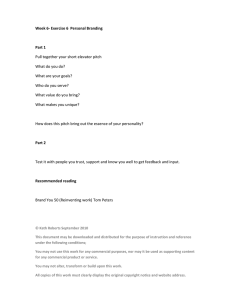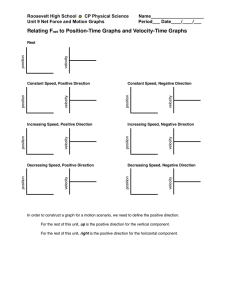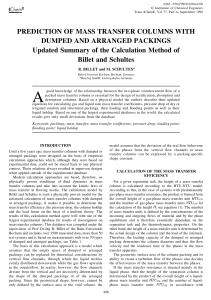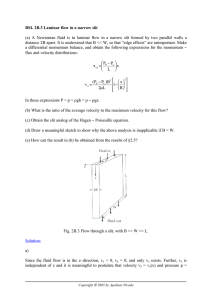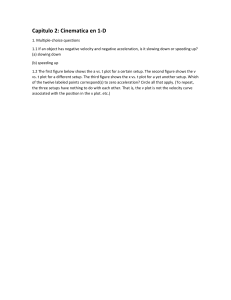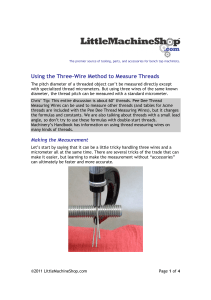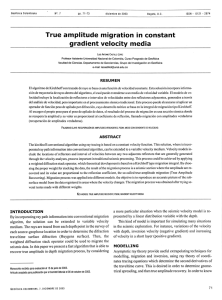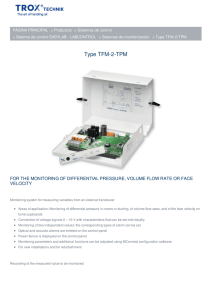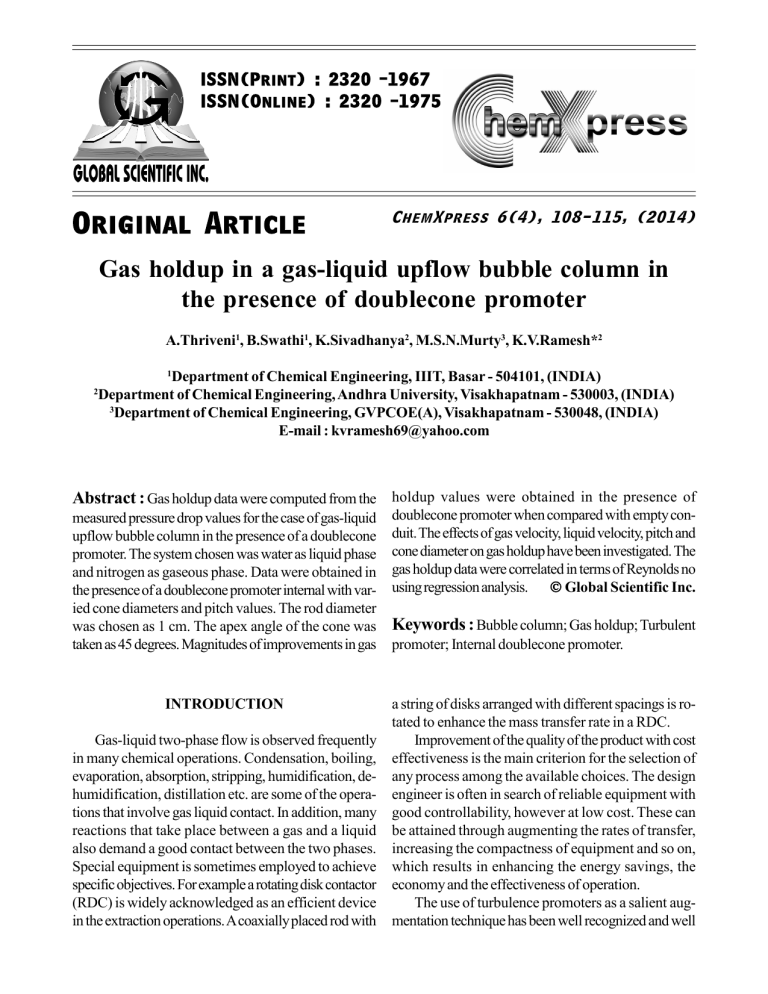
ISSN(Print) : 2320 –1967 ISSN(Online) : 2320 –1975 Original Article ChemXpress 6(4), 108-115, (2014) Gas holdup in a gas-liquid upflow bubble column in the presence of doublecone promoter A.Thriveni1, B.Swathi1, K.Sivadhanya2, M.S.N.Murty3, K.V.Ramesh*2 1 Department of Chemical Engineering, IIIT, Basar - 504101, (INDIA) Department of Chemical Engineering, Andhra University, Visakhapatnam - 530003, (INDIA) 3 Department of Chemical Engineering, GVPCOE(A), Visakhapatnam - 530048, (INDIA) E-mail : [email protected] 2 Abstract : Gas holdup data were computed from the holdup values were obtained in the presence of measured pressure drop values for the case of gas-liquid upflow bubble column in the presence of a doublecone promoter. The system chosen was water as liquid phase and nitrogen as gaseous phase. Data were obtained in the presence of a doublecone promoter internal with varied cone diameters and pitch values. The rod diameter was chosen as 1 cm. The apex angle of the cone was taken as 45 degrees. Magnitudes of improvements in gas doublecone promoter when compared with empty conduit. The effects of gas velocity, liquid velocity, pitch and cone diameter on gas holdup have been investigated. The gas holdup data were correlated in terms of Reynolds no using regression analysis. Global Scientific Inc. INTRODUCTION a string of disks arranged with different spacings is rotated to enhance the mass transfer rate in a RDC. Improvement of the quality of the product with cost effectiveness is the main criterion for the selection of any process among the available choices. The design engineer is often in search of reliable equipment with good controllability, however at low cost. These can be attained through augmenting the rates of transfer, increasing the compactness of equipment and so on, which results in enhancing the energy savings, the economy and the effectiveness of operation. The use of turbulence promoters as a salient augmentation technique has been well recognized and well Gas-liquid two-phase flow is observed frequently in many chemical operations. Condensation, boiling, evaporation, absorption, stripping, humidification, dehumidification, distillation etc. are some of the operations that involve gas liquid contact. In addition, many reactions that take place between a gas and a liquid also demand a good contact between the two phases. Special equipment is sometimes employed to achieve specific objectives. For example a rotating disk contactor (RDC) is widely acknowledged as an efficient device in the extraction operations. A coaxially placed rod with Keywords : Bubble column; Gas holdup; Turbulent promoter; Internal doublecone promoter. ChemXpress 6(4), 2014 109 Original Article reported. Bergles[1] presented a comprehensive review of investigations using various types of turbulent promoters in homogeneous flow. Interaction between various flow patterns has been attributed to the augmentation. Significant improvements in mass transfer coefficient were found by introducing a gas phase into a homogeneous fluid. This is attributed to the turbulence and agitation promoted by the gas phase[2]. Further augmentation can be obtained by introducing a turbulent promoter into gas-liquid flow. Ramesh et al[3] investigated the augmentation of mass transfer coefficients in a gas-liquid upflow bubble column in the presence of a helicoidal tape promoter. Sarma et al[4] employed a disc promoter in gas liquid two phase flow. Suresh et al[5] used an hourglass promoter in gas liquid up flow bubble columns for enhancement of mass transfer coefficients. Although few works have been reported in the literature using promoter elements for enhancement of mass transfer rates in gas-liquid upflow bubble columns, the works reporting on gas holdup were found to be scarce. Since the holdups are important design parameters of bubble columns, it is essential to know the behavior of holdups in the presence of such promoters. Knowing gas holdup permits us to know liquid holdup because sum of the holdups is unity. For the present work, the doublecone promoter has been chosen. This is because the cone promoter is much superior compared to other internal elements in mass transfer[6,7]. An attempt has been made to develop generalized correlations through empirical modeling using dimensionless groups involving flow parameters and the geometric parameters of the promoter assembly. The ranges of variables covered are compiled in TABLE 1. TABLE 1 : Range of variables covered in the present study S.No. Parameters studied Minimum Maximum 1 Superficial velocity of gas 0.014 0.07 Ug, m/s 2 Superficial velocity of liquid 0.04 0.27 UL, m/s Diameters of the rod (di), 3 1.0 --cm 4 Pitch, p in cm 7.0 10.0 5 Diameter of cone, dc, cm 3.0 5.0 6 Apex angle (degrees) 45 --- EXPERIMENTAL The equipment was designed and fabricated to carryout studies on gas holdup in a gas-liquid upflow bubble column. A string of doublecone elements fixed on a rod with different pitches was employed as a promoter assembly, which was placed concentrically in the electrochemical cell. The schematic diagram of the experimental set-up used in the present investigation was shown in Figure 1. The equipment and apparatus consisted of a sintex cylindrical storage tank (S), a centrifugal pump (P) for circulating the water, two rotameters (R1 & R2) for measuring the flow rates of water and nitrogen gas respectively, a nitrogen cylinder (N) for supply of nitrogen gas and a pressure regulator to regulate the nitrogen flow from the high pressure cylinder. A U-tube differential manometer (U) was provided to measure the pressure difference across the test section (B). Valves V1 to V5 were used to control the flow rates of liquid while valve V6 was used to control the flow rate of the gas through the experimental column. The storage tank has a capacity of 100 liters. The bottom side of the tank was connected to the suction side of the pump (P) through a globe valve (V1). Another globe valve (V2) was provided at the bottom of the storage tank to facilitate the periodic cleaning. The pump (P) of Kirloskar make was made of stainless steel, has a capacity of 1 hp. The discharge end of the pump was divided into two lines, one directly connected to a liquid rotameter (R1) and the other to a by-pass line. The by-pass line was provided with a globe valve V3 to control the flow through rotameter. The rotameter (R1) was of Indus make has range of 0 to 60 liters per minute. One more valve V4 was provided at the entry point of rotameter. Valve V5 provided at the discharge end of the rotameter facilitated the fluid electrolyte to flow through the experimental column. The experimental column shown in Figure 1 mainly consisted of the following three sections: an entrance calming section (A), a test section (B) and an exit section (gas-liquid separator) (C). The entrance calming section (A) made of a copper tube of 6.73 cm inner diameter and 1.07 m long, was filled with marble stones of random size, to eliminate the effects due to tangential entry of the liquid and to minimize the fluctuations and 110 . ChemXpress 6(4), 2014 Original Article enabling uniform distribution of the gas and liquid in the flow. This section was connected to the main test section (B) by means of a flange (F1). The two inlets provided at the bottom of the entrance calming section facilitated the flow of the metered water and metered nitrogen gas. The flow rate of nitrogen gas was measured using a pre calibrated nitrogen gas rotameter of Indus make. A sparger made of stainless steel was provided at the bottom inlet point for admitting gas uniformly into the experimental column. The test section (B) was made of smooth perspex tube of 6.73 cm inner diameter and 0.6 m height. Two pressure taps, (T1) at the bottom flange and (T2) at the top flange have been provided across the test section for pressure drop measurements. The Taps (T1 and T2) were connected to the limbs of the U-tube manometer to measure the pressure drop. Carbon tetrachloride was used as manometric fluid. A stainless steel wire mesh (W) was placed at the bottom of the test section to allow the uniform distribution of liquid and gas into the experimental column. Two cones of given diameter dc were joined together at the bases in the form of a doublecone and this arrangement was used as the repeating element in the promoter assembly. Doublecone elements of different sizes were placed concentrically on a stainless steel rod of diameter dr with varied pitch p. This essentially acted as the promoter element. The schematic diagram of this promote element was shown in Figure 2. Promoter elements of different geometrical characteristics (viz., rod diameter dr, pitch p, cone diameter dc) were fabricated and the details of the promoter geometries used in the present study were compiled in TABLE 2. The exit section (C) was also of the same diameter as A and B with its open end into the gas-liquid separator was connected to the test section (B) by means of a flange F2. Open end was provided to vent the gas into the atmosphere (V) and the water from the test section was drawn from the bottom of the separator (D). During experimentation, the water flow rate was adjusted by using the control and by pass valves. After the flow was stabilized metered nitrogen gas, was bubbled through a sparger provided at the bottom end of the entrance calming section. When the liquid and gas-flow rates were stabilized, the pressure difference across the test section is obtained by measuring the reading of the manometer. The computation of gas holdup was made from pressure drop measurement in the lines similar to those reported earlier in the studies on gasliquid upflow bubble columns[8]. RESULTS AND DISCUSSION Before commencing the experimentation with the present set up, gas holdup data were obtained in gas- Figure 1 : Schematic of experimental unit; A – entrance alming section; B – test section; C – exit section; CC – copper coil; D – distributor; DR – drain; F1, F2 – flanges; N – nitrogen cylinder; P – pump; R1, R2 – rotameters; S – storage tank; T1, T2 – pressure tapings; U – manometer; V – vent; V1 to V7 – valves. ChemXpress 6(4), 2014 111 Original Article be realized on higher gas velocity end. These observations indicate that the presence of a doublecone promoter assembly in a two-phase gas-liquid upflow bubble column is advantageous as it increases gas holdup. Effect of liquid velocity Figure 4 shows the effect of liquid velocity on gas holdup in the gas-liquid upflow bubble column with coaxially placed doublecone promoter. The gas holdup data presented in this graph corresponds to a cone dia of 4 cm, pitch of 7 cm and a constant gas velocity of 0.0234 m/s. An examination of the plot of the graph reveals that the gas holdup decreases with increase in liquid velocity. The reason for this behavior can be explained as following. As the liquid velocity is increased, by keeping the gas velocity at a constant value, more gas was driven away by the liquid in the upward direcFigure 2 : Details of the doublecone promoter; dr – rod diamtion by virtue of drag forces. Hence more liquid was eter; dc – base diameter of cone; p – pitch; è – apex angle of present in the test section. Therefore, the fraction of cone liquid i.e., the liquid holdup was more thus leading to a TABLE 2 : Details of the doublecone promoters employed in reduction in the gas holdup. the present study (a) Effect of pitch Apex Diameter Diameter Pitch, p S.No. of the rod angle of cone, Gas holdup data obtained in the present experi(cm) (degrees) dc (cm) dr(cm) ment for two cases of pitch values viz., 7 and 10 cm 1 1.0 45 7 3 have been plotted against liquid velocity and shown in 2 1.0 45 7 4 Figure 5. A close inspection of the plots of the figure 3 1.0 45 7 5 reveals that the effect of pitch on gas holdup was insig4 1.0 45 10 4 nificant when considered against liquid velocity. It can liquid upflow bubble column without any internal. The be explained in the following way. Since the flowing åg values thus obtained were found to agree the data of fluids were subjected to contractions and expansions in the longitudinal direction, the gas bubbles were subKhamadieva and Böhm[8] within 5% deviation. jected to bubble coalescence and bubble disintegraEffect of doublecone promoter tion. Hence severe turbulence appears in the flow area. Figure 3 gives the data of the present study plotted However, it can be understood that the turbulence is as gas holdup against gas velocity for two cases of (i) maximum with the pitch value of 10 cm and by degas-liquid flow in empty conduit (Plot A) and (ii) gas- creasing the pitch to 7 also, no additional turbulence liquid flow with doublecone promoter (Plot B). The could be generated. Hence no remarkable effect of pitch magnitudes of improvements in gas holdup over empty on gas holdup could be observed. conduit were shown in plots A and B. Plot A was the (b) Effect of cone diameter data predicted form Khamadieva and Böhm[8] for the To investigate the effect of cone diameter on gas case of gas-liquid upflow in an empty conduit. The holdup, the data on gas holdup were plotted against present data obtained in gas-liquid flow with doublecone promoter were presented as plot B. Plots A and B show liquid velocity for three cases of cone diameter considthe improvements in gas holdup resulting due to the in- ered in the present experiment viz., 3, 4 and 5 cm. The troduction of the doublecone promoter were upto 4 plots thus drawn were shown in Figure 6. An examinafold on lower gas velocity end. Upto 60% increase could tion of the plots of the figure revealed that the influence 112 . Original Article Figure 3 : Effect of promoter on gas holdup Figure 4 : Effect of liquid velocity on gas holdup. Figure 5 : Effect of pitch: Variaton of gas holdup with liquid velocity ChemXpress 6(4), 2014 ChemXpress 6(4), 2014 113 Original Article of cone diameter on gas holdup was marginal, when considered against liquid velocity. Effect of gas velocity Figure 7 shows the effect of gas velocity on gas holdup. It can be expected that an increase in gas velocity would drive away more liquid by means of its buoyancy forces and hence the gas occupies more volume. Hence more value of gas holdup can be anticipated. In the present experiment, the data obtained on gas holdup against liquid velocity for the case of cone dia of 4 cm, pitch of 7 cm and a constant liquid velocity of 0.121 m/s. It is observed from the plot of the Figure 7 that the gas holdup increased with increase in gas velocity. This observation is in the same lines as expected. (a) Effect of pitch Gas holdup data obtained in the present experiment for two cases of pitch values viz., 7 and 10 cm have been plotted against gas velocity and shown in Figure 8. Plot A corresponds to a pitch value of 7 cm and plot B corresponds to a pitch value of 10 cm. A close inspection of the plots of the figure reveals that the effect of pitch on gas holdup was significant when considered against liquid velocity. It can be explained in the following way. Since the flowing fluids were subjected to contractions and expansions in the longitudinal direction, the gas bubbles are subjected to bubble coalescence and bubble disintegration. Hence severe turbulence appears in the flow area. As the pitch value is increased the bubble disintegration is favored more because of overlapping of wakes. Hence, an increase Figure 6 : Effect of cone dia: Variation of gas holdup with liquid velocity Figure 7 : Effect of gas velocity on gas holdup. 114 . Original Article Figure 8 : Effect of pitch: Variation of gas holdup with gas velocity Figure 9 : Effect of cone dia: Variation of gas holdup with gas velocity Figure 10 : Correlation plot in accordance with eqn. (1) ChemXpress 6(4), 2014 ChemXpress 6(4), 2014 115 Original Article in the gas holdup could be observed. (b) Effect of cone diameter To investigate the effect of cone diameter on gas holdup, the data on gas holdup were plotted against liquid velocity for three cases of cone diameter considered in the present experiment viz., 3, 4 and 5 cm. The plots thus drawn were shown in Figure 9. An examination of the plots of the figure revealed that the influence of cone diameter on gas holdup was significant, when considered against gas velocity. An increase in cone dia resulted a decrease in gas hold up. This observation is also conspicuous from inset Figure 9a. Correlation The data on åg have been correlated by regression analysis and the following equation is obtained. g 1.876 Re 0.17 Frg 0.12 p d c 0.23 NOMENCLATURE dc Dc Frg : doublecone diameter [m] : column diameter [m] U g2 g p : Froude number = gD c : acceleration due to gravity [m/s2] : pitch [m] Re : Reynolds number = Ug UL : gas velocity [m/s] : liquid velocity [m/s] ñ L Dc U L ìL Greek symbols å g : gas holdup [-] ñ L : liquid density [kg/m3] µL : liquid viscosity [kg/m.s] (1) The correlation plot according to equation (1) has been shown in Figure 10 CONCLUSIONS Experiments were conducted to investigate the effect of various pertinent dynamic and geometric variables on gas holdup in a two-phase upflow bubble column in the presence of a coaxially placed doublecone promoter. Gas holdup data were obtained from measured pressure drop data across the test section. The gas holdup data were analyzed for individual parametric effects and the following conclusions were drawn: Gas holdup value obtained in the presence of double cone promoter is about 4 times in comparison with the case of absence of promoter. The gas holdup was found to decrease with increasing liquid velocity. The parametric effects of pitch and cone diameter on gas holdup were found to be insignificant when liquid velocity was varied at a constant gas velocity. The gas holdup was found to increase with increasing gas velocity. The gas holdup decreased with increasing pitch and cone diameter values when gas velocity was increased at a constant liquid velocity. The entire data on gas holdup were represented by the correlation equation in åg -Re format. REFERENCES [1] A.E.Bergles; Keynote at the 5th International Conference on Boiling Heat Transfer, Montego Bay, May 4-8, Jamaica, (2003). [2] A.Yasunishi, M.Fukuma, K.Muroyama; Wall-to-liquid mass transfer in packed and fluidized beds with gas-liquid counter flow, J.Chem.Eng.Japan, 21, 522528 (1988). [3] K.V.Ramesh, G.M.J.Raju, M.S.N.Murty, C.Bhaskara Sarma; Wall-to-bulk mass transfer in a two-phase upflow bubble column with a composite promoter, Indian Chem.Eng., 51(3), 215-227 (2009). [4] G.V.S.Sarma, M.S.N.Murty, K.V.Ramesh, G.M.J.Raju; Wall-to-bulk mass transfer in gas-liquid upflow bubble column with disc promoter, J.Energy Heat MassTransfer, 33, 233-249 (2011). [5] S.Suresh, M.S.N.Murty, B.Srinivas, K.V.Ramesh; Wall-to-bulk mass transfer in co-current gas liquid upflow bubble column using hourglass promoters, J.Instn.Engrs.(India): Series E, 94(2), 91-96 (2013). [6] G.J.V.Jagannadha Raju, P.Venkateswarlu, S.Sarveswara Rao; Pressure drop studies with string of cones as turbulent promoter, Ind.J.Tech., 18, 229-231 (1980). [7] S.Sarveswara Rao, G.J.V.J.Raju; Studies on ionic mass transfer with coaxially placed cones on a rod (CPCR internal) in homogeneous fluid and fluidized beds, Paper presented at World Congress III of Chemical Engineers, Tokyo, Japan, 481 (1986). [8] R.Khamadieva, U.Böhm; Mass transfer to the wall of a packed and unpacked bubble column operating with Newtonian and non-Newtonian liquids, Chem.Eng.J., 116(1), 105-113 (2006).
